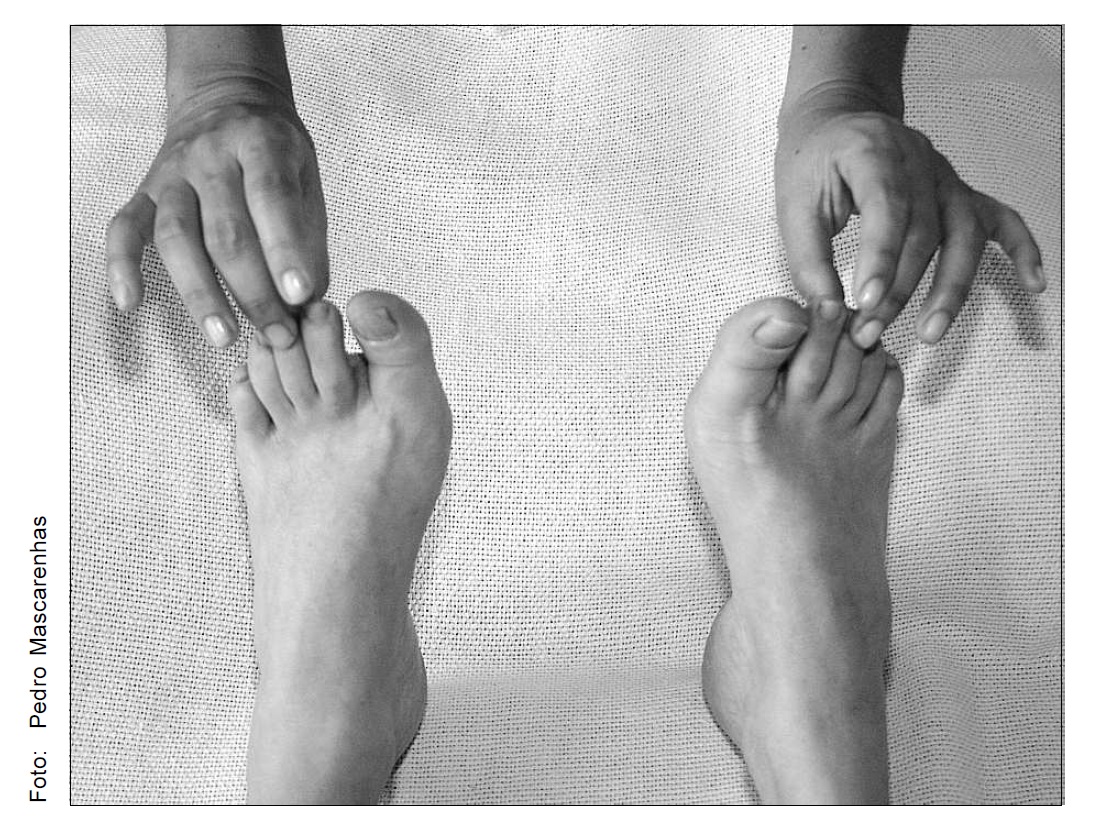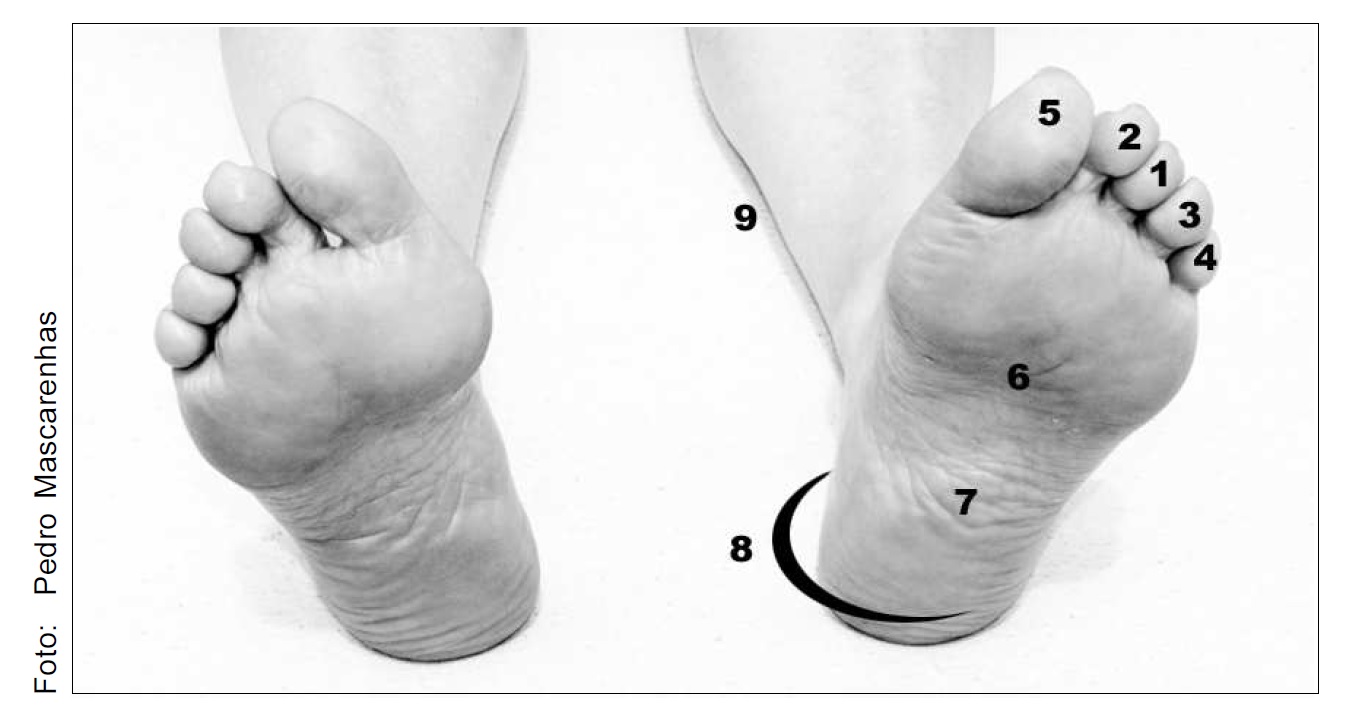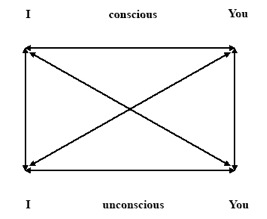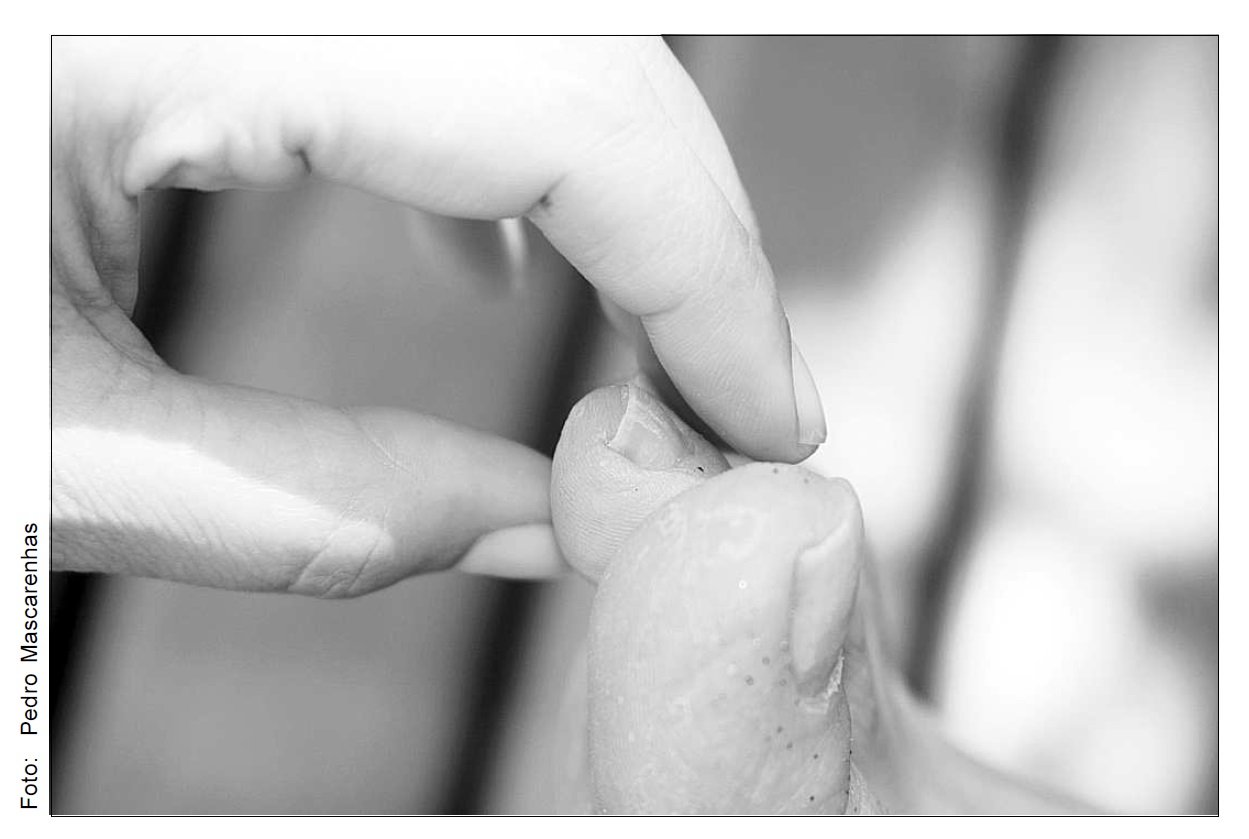Calatonia and Subtle Touches: The Method
Calatonia and Physiopsychic Integration - Cortese, F. - chapter 3
Yoga teaches yoga.
Patanjali
Calatonia is essentially living experience and practice. Thus, in providing the description and characteristics of the method, this chapter is only a bibliographic reference, and it does not replace the learning practice indispensable to its application. We may be reminded of the old saying by Patanjali, who first codified yoga: “Yoga teaches yoga.”
Calatonia arose from the practical need to attend to the sick in hospitals for war- wounded, which lacked medical resources and functioned in highly precarious situations. Touching the feet is the continuation of a comforting conversation with the doctor at the foot of the patient’s bed. Touch here is the recovery of an inherent part of the therapist/patient relationship, which, unfortunately, is very much forgotten nowadays. In this initial experience, Dr Sándor observed the effects produced in patients, with different degrees of relief in their discomfort and pain, and improved his method. He related this experience to the psychosomatic medicine and philosophical principles on which he based his work and life, as we shall see in the following chapters.
Calatonia developed until it became a therapeutic method that comprises the technique of body work, the posture of the therapist and the vision of man as subjacent to the contact, to the evaluation and treatment of the patient. For this reason, the background of the therapist – firstly, his own education, obtaining a college degree in the health area and, later, with a specialization in some of the many courses and groups organized by Sándor’s disciples – is considered essential so that the therapy is not just a reproduction of the technique, but an insertion of the therapist in the method.
In order to apply Calatonia, one touches very lightly – “like someone who wishes to hold a soap bubble” – the distal phalange of the toes, using the corresponding fingers of the hands. The sequence middle (1)/index(2)/ring (3)/small(4)/hallux(5) corresponds to the hierarchy of the elements earth/water/fire/air and its synthesis (as explained in the chapter on Astrology). Next, one touches the sole of the foot in two points: just below the plantar arch(6) and just above the calcaneous(7). In the eighth, holding the heel the therapist touches around the malleolus. After this, he touches the beginning of the calf muscle at the point where the sural triceps converge (9).


In his book Técnicas de relaxamento Professor Sándor explained the origin of the word “Calatonia”. According to him, in Greek the verb khalaó means “relaxation” and also “feeding”, “getting away from the state of wrath, fury, violence”, “opening of a door”, “untying the knots of a wineskin”, “letting go”, “forgiving one’s parents”, “withdrawing all veils”. It is interesting to note that, with this concise observation, typical of Sándor, he pointed to the consideration of Calatonia as an extensive method related to aspects of deep psychology.
In addition, Calatonia literally means “appropriate tonus” which translates in a concrete manner the effects observed with this relaxation. The observation and reporting of such effects have been effectuated by a group of hundreds of therapists for more than five decades. The adjustment of the tonus, also called by Sándor “physiopsychic reconditioning”, may be described at three levels: physical, emotional and mental.
. Physical level: Muscular relaxation, muscular de -contraction, regulation of several vegetative functions, such as; breathing, blood and lymphatic circulation, heartbeats, visceral functioning, temperature and arterial pressure.
. Emotional level: Corresponding relaxation and regulation of “emotional tonus”, that is, reorganization of emotions loaded in an imbalanced way by daily events and by various levels of unconscious conflicts.
. Mental level: regulation of “mental tonus” with the elimination of various spurious mental contents, conditioned by the daily exposure to a huge amount of stimuli and, at a deeper level, the overcoming of mental categories conditioned by existing education and culture.
Each of these three levels of human existence includes aspects considered “unconscious”. At the physical level, the body functions described are functions of the vegetative or autonomous nervous system, that is, they are independent from the command of the consciousness. Here, one can see how the experience of the human being is basically and essentially, unconscious. For instance, if we do not breath, we soon die, but this primordial function is in fact controlled by the autonomous nervous system.
In parallel, our emotions and feelings have a predominantly unconscious component, that is, we are not aware of the main aspects of these emotions and feelings.
The same is true for the mental level: the return to balance of all our physiopsychic system occurs basically at an unconscious level, and for this reason, the techniques for body relaxation and touch have a reorganizing effect even though the contact and exchange take place at the bodily level, without verbal participation. It is logical then that when it is possible to have a constructive and synthesizing verbal level, one gains a further degree of consciousness, which is an important factor in human development.
As an illustration of the exchange between therapist and patient, we can be reminded of the scheme used by Jung and by Guggenbuhl-Craig to represent this relationship – with the conscious x conscious, conscious x unconscious and unconscious x unconscious planes -, when both participate and move in that larger organism of which they are a part.

The illustration represents the therapist/patient relationship according to this vision, in which the conscious level is the basis. For instance, there must be an adequate contact, contract, setting. However, the unconscious level is always present – even though this enunciation itself already demonstrates our misuse of language, the result of our egoic inflation. This is because we are always immersed in the unconscious, that is, it is not possible for the limited consciousness to embrace the entirety of our experience, neither physical (remember breathing), nor psychic.
The old Freud already pointed this fact out in 1900, but even today our consciousness resists its assimilation, distorted by cultural conditionings that sustain the fantasy illusion that our little conscious and rational portion may understand and control the whole personality. It is a serious illusion. Man may not control the physical or psychic nature; it cannot even understand it totally. He is part of it and functions according to its laws. As Jung said, it is the unconscious that determines if I will be able to pronounce (or write) the next word. This illusion of contemporary man has serious consequences; the physical and psychic nature resents its unilateral and predatory action and exhibits the resulting imbalances.
For this reason the reintegration of man with nature is one of the bases of our work. This re-approximation of the patient with nature is propitiated by various elements. To lie down, to take off ones clothes, to close the eyes already represent - symbolically and physiologically – an alteration of the rhythm of bodily and psychic functions. To abandon oneself to the proposed touch and to allow the perceptions to be experienced enable one to feel the contents of the innermost layers. And the stimulus of the touch, by providing muscular de-contraction, rebalancing respiratory, circulatory and other functions, complements the creation of the physiopsychic field that makes this experience possible.
The ways in which we work – Calatonia, readjustment of support points, subtle touches - provides a peculiar physiopsychic commutation that leads to an altered state of consciousness, to a kind of change in the functioning strip of the ego in its daily watch, with sensations and images that are peculiar to this strip. This allows for an experience of contents which is distinct from the ordinary. This experience helps in the de-conditioning of the ego, it helps to overcome those categories of standard thoughts, feelings and sensations imposed by the mass culture with which we are involved.
Here we have the possibility of a deeper and authentic contact with aspects of our unconscious I, the center of the personality that Jung called Self. This reconnection is essential so that man may guide his path of individuation towards realizing the potential that is present in the Self, in the actual self concealed and distorted in our culture by the ego’s conditioned and imbalanced wishes and aspirations. The ego wants to realize itself, but the Self toowants to realize itself in its own dimension, that is, to fulfill the destination of that individual organism of participating harmoniously and integrally in That bigger Organism of which he is a part. The conscious psyche of present day man suffers from a deformation that is characteristic of our culture: the inflation of the ego, which, in exceeding its original function, aims at controlling and determining the process of Being.
The objectives of Calatonia may also be described according to the following aspects:
- Contact with oneself
- Reconnection with the bigger organism of which we are a part
- Prophylaxis instrument
- Diagnostic instrument
- Instrument of differentiated and deep interaction with the other
Contact with oneself – Primarily contact with the bodily sensations, the perception of which is facilitated by relaxation and the cutting off of external stimuli. On a deeper layer, according to the different planes of consciousness that are reached, connection with aspects that Jung called self, or inner center of the psyche (or Higher Self, according to some spiritualist systems). Through activation of the intuitive function, by way of touch, that is, by its opposing sensation function, one creates a physiopsychic state that favors the state of consciousness which in turn facilitates access to deeper levels of the psyche.
These levels were described by Jung in the concept of the collective unconscious. The important biologist Rupert Sheldrake also described unconscious levels of communication in the concept of morphogenetic fields. In another approach, and using different language, there is the notion of various planes of consciousness in Theosophy, contacted and transmitted according to the development of the aspirant or disciple in his process of personal development.
Reconnection with the bigger organism of which we are a part – Reconnection at a physical, social level, of species, planet and cosmos: hólos, “total, complete, whole.”
Prophylaxis instrument – Helping to balance physical and psychic functions, as well as making deeper and discriminated self-observation possible. This enables the patient to contact and, if necessary, to deal with sensations of physical pain or discomfort which remain unnoticed in normal daily activities.
Diagnostic Instrument – For the therapist, who also has his own perception channels (sensation and intuition) activated, in a diversified observation of his patient. This is a difficult aspect to describe theoretically, it needs to be experienced so that the therapist realizes how his intuitive understanding of the patient can be dynamized through body work. Beginner students are surprised with patients who, when they return, report that the therapist touched exactly where it hurt or where it was necessary, or that after body work the therapist approached exactly the area that was most significant at that moment.
Instrument of differentiated and deep interaction with the other – In Calatonia the exchange is dialectic; therapist and patient touch each other within a field that confronts, interchanges, integrates and transcends both, constellating that energy of synthesis Jung called transcendent function, originating from the unconscious personality and named the third point by Dr Sándor.
With the concept of the third point, Sándor proposed that the therapist seek to visualize or feel, in the most appropriate manner for him and his patient, that tertius that transcends the dichotomy of two human beings in contact with each other and integrates the two in a more global dynamism which contains them.
In order to realize this work and its objectives, it is necessary for the therapist to have an internal attitude of surrendering to the process and letting go of pre-conceived ideas and intentions. After appropriate training in the method and with proper supervision and experience, the therapist will learn in that moment to disconnect from his channels of evaluation (thought and feeling functions), which are very conditioned, both socially and culturally. Here, the feeling/intuition axis works better when we observe the patient, “listen to him” with the tip of our fingers and let the impressions and directions coming from the unconscious through the intuitive function determine the work to be done.
With time, as a consequence of this interaction and this practice, new forms of body work were “constellated” in Sándor’s work and that of his group. Thus, the so called “subtle touches” arose, in which, according to the same principles and the same methodology, other techniques are used to attain analogous objectives.
There are other forms of Calatonia (hands and head) - the work with; “fractioned decompression”; with large and small joints; with opposites (superior/inferior limbs, scapular girdle / pelvis, foot / head, right/left sides); and with the spine and its nervous and energetic centers as well as many others. The continuous development of this work and the consciousness of the groups in relation to our practice and to the fundamental Ideas that form the basis of this practice prove the role of Calatonia as both a generator and producer of knowledge.
In this work, the search for de-conditioning is essential and, therefore, the effort to “detach” oneself from daily experiences and dynamisms in order to perceive another layer of the psyche’s contents. The type of touch that we have adopted aims at this unconditioned, non- habitual, more archaic characteristic – for example, the touch on the feet or on the spine, the subtle intensity. Group forms are also adopted, with configurations that evoke the archetype – the circle, the holding of hands, the dance, and the emission of primordial sounds (like A’).
In this way, Calatonia has been used as a coadjuvant method in Psychological, Medical, Speech and Physio therapies, as well as occupational and body therapies. It is also used in Physical Education, Pedagogy and in various group work forms. Under conditions in which the proposal, the setting and the preparation of the therapist were seen to be appropriate, no counter-indications were observed. It is possible to work with psychotics (although in certain cases lower levels of responsiveness were observed ), as well as with patients under psychiatric medication; in any event, the results observed support the merit of the attempt. Calatonia and Subtle Touches can be extremely valuable resources in pre and post-surgical and hospital situations in general.
The objective of Calatonia may be characterized as being general and unspecified, as opposed to body works that have specific – focused - objectives, as is the case with physiotherapy and other body therapy approaches. There is no expectation regarding pre-determined programmable results, however, the observation for more than five decades now of the application of the method to thousands of patients has shown results analogous to those described here, within a physical and psychic re-balancing framework, favoring consciousness, self-perception and self- direction, in the sense of the appropriate realization of potentialities (individuation).

References
Delmanto, Suzana. Toques sutis. 2nd ed. São Paulo: Summus, 1997.
Farah, Rosa. Integração psicofísica. São Paulo: Companhia Ilimitada e Robe Editorial, 1995.
Sándor, Pethö. Técnicas de relaxamento. 4th Ed. São Paulo: Vetor, 1982.


